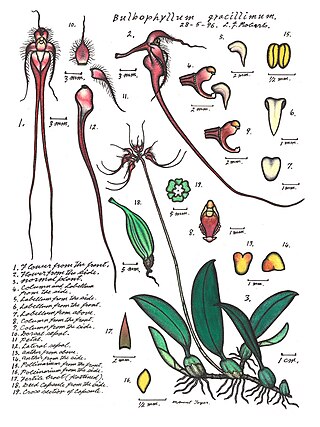| Image | Name | Distribution | Elevation (m) |
|---|
| Bulbophyllum adolinae Schuit., Wanma, Mambor & Heatubun 2018 | western New Guinea | 1,970 metres (6,460 ft) |
| Bulbophyllum aechmophorum J.J.Verm. 1993 | New Guinea | 1,800–2,900 metres (5,900–9,500 ft) |
| Bulbophyllum algidum Ridl. 1916 | New Guinea | 3,200 metres (10,500 ft) |
| Bulbophyllum alveatum J.J.Verm. 1993 | Papua New Guinea | 1,800–2,000 metres (5,900–6,600 ft) |
 | Bulbophyllum ankylochele J.J.Verm. 1993 | New Guinea | 1,700–2,300 metres (5,600–7,500 ft) |
| Bulbophyllum aphanopetalum Schltr. 1906 | New Guinea, New Caledonia and Fiji | 1,700–2,300 metres (5,600–7,500 ft) |
| Bulbophyllum artostigma J.J.Verm. 1993 | Papua New Guinea | 200–1,200 metres (660–3,940 ft) |
| Bulbophyllum bliteum J.J.Verm. 1993 | New Guinea | |
| Bulbophyllum brachypetalum Schltr. 1913 | New Guinea | 2,200–3,000 metres (7,200–9,800 ft) |
| Bulbophyllum brassii J.J.Verm. 1993 | New Guinea | 1,300 metres (4,300 ft) |
| Bulbophyllum calviventer J.J.Verm. 1993 | eastern New Guinea | 2,700–3,100 metres (8,900–10,200 ft) |
| Bulbophyllum concavibasalis P.Royen 1979 | New Guinea | 3,300 metres (10,800 ft) |
| Bulbophyllum cycloglossum Schltr. 1913 | New Guinea | 2,500–3,400 metres (8,200–11,200 ft) |
| Bulbophyllum discolor Schltr. 1913 | New Guinea | 1,000 metres (3,300 ft) |
| Bulbophyllum hapalocodon J.J.Verm., Schuit. & de Vogel 2018 | western New Guinea | 2,600–2,700 metres (8,500–8,900 ft) |
| Bulbophyllum hiljeae J.J.Verm. 1991 | Papua New Guinea | 2,000 metres (6,600 ft) |
| Bulbophyllum inciferum J.J.Verm. 1993 | New Guinea | 2,000 metres (6,600 ft) |
| Bulbophyllum kenae J.J.Verm. 1993 | New Guinea | 2,800–3,100 metres (9,200–10,200 ft) |
| Bulbophyllum lophoton J.J.Verm. 1993 | New Guinea | 2,200–2,300 metres (7,200–7,500 ft) |
| Bulbophyllum minutipetalum Schltr 1913 | Papua New Guinea | 1,900–2,000 metres (6,200–6,600 ft) |
| Bulbophyllum nubigenum Schltr. 1913 | New Guinea | 2,400 metres (7,900 ft) |
| Bulbophyllum octarrhenipetalum J.J.Sm. 1913 | New Guinea, Vanuatu | 1,600–2,300 metres (5,200–7,500 ft) |
| Bulbophyllum origami J.J.Verm. 1993 | Papua New Guinea | 2,000–2,200 metres (6,600–7,200 ft) |
| Bulbophyllum ortalis J.J.Verm. 1993 | New Guinea | 1,700–2,000 metres (5,600–6,600 ft) |
 | Bulbophyllum patella J.J.Verm. 1993 | Papua New Guinea | 1,600–2,500 metres (5,200–8,200 ft) |
| Bulbophyllum peltopus Schltr. 1913 | Papua New Guinea | 1,300 metres (4,300 ft) |
| Bulbophyllum plicatum J.J.Verm. 1993 | New Guinea | 1,800 metres (5,900 ft) |
| Bulbophyllum ptychantyx J.J.Verm. 1993 | eastern New Guinea | 2,500–3,000 metres (8,200–9,800 ft) |
| Bulbophyllum reevei J.J.Verm. 1992 | New Guinea | 2,100–3,100 metres (6,900–10,200 ft) |
| Bulbophyllum rhodoleucum Schltr.1913 | eastern New Guinea | 1,800–2,800 metres (5,900–9,200 ft) |
| Bulbophyllum santoense J.J.Verm. 1993 | Vanuatu and Espiritu Santo | 1,500–1,600 metres (4,900–5,200 ft) |
| Bulbophyllum scutiferum J.J.Verm. 1993 | New Guinea | 2,300–3,300 metres (7,500–10,800 ft) |
| Bulbophyllum subapetalum J.J.Sm. 1915 | New Guinea | |
| Bulbophyllum thelantyx J.J.Verm. 1993 | New Guinea | 1,800–3,000 metres (5,900–9,800 ft) |
| Bulbophyllum triaristella Schltr. 1913 | New Guinea | 1,000–3,300 metres (3,300–10,800 ft) |
|

















